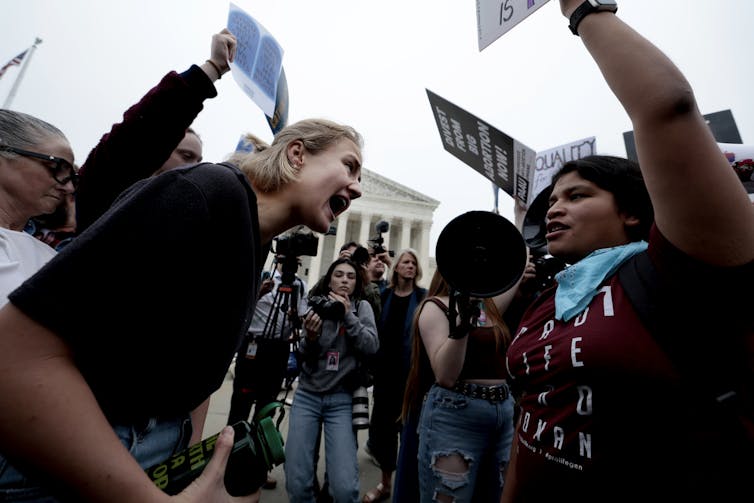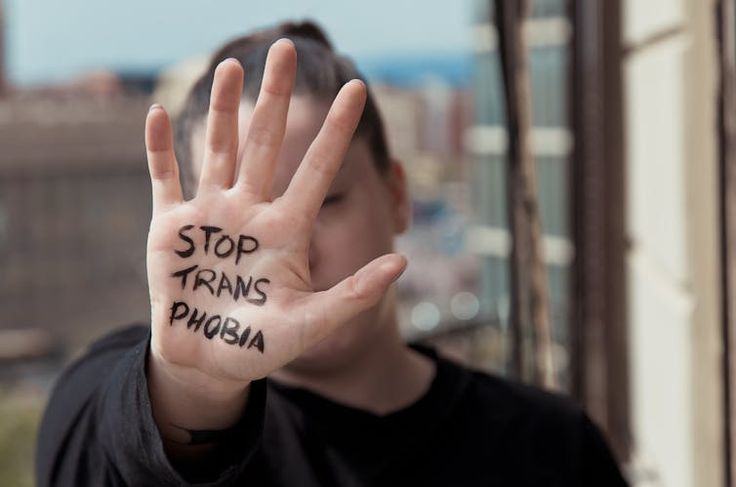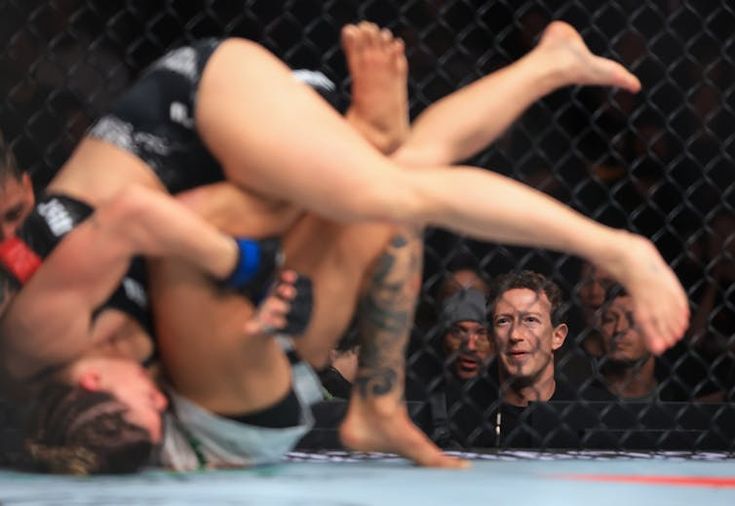
Stefani Reynolds/AFP via Getty Images
Matt Williams, The Conversation
A leaked draft opinion written by Justice Samuel Alito suggests the Supreme Court is on the brink of overturning two rulings, including Roe v. Wade, that guarantees the right to abortion in the U.S.
The Supreme Court confirmed that the document, obtained and first reported on by Politico, is actual but said, “Although the document described in yesterday’s reports is authentic, it does not represent a decision by the court or the final position of any member on the issues in the case.”
The opinion is due to be issued later in the year. The leaked document indicates that a conservative majority in the court is on track to end a woman’s constitutional right to abortion, opening the door for states to enact bans.
Although a seismic development in the long-running legal battle and social debate over abortion rights, the development is not entirely unexpected. In recent years, pro-abortion rights advocates have been ringing alarm bells over threats to Roe. Legal scholars, health experts, and sociologists have helped explain in The Conversation U.S. what is at stake and what it would mean for American women should the historic ruling be overturned.
1. How Roe changed women’s lives
A lot has changed in the nearly 50 years that separate the constitutional enshrining of the right to abortion in the U.S. to the brink of ending that right.
Constance Shehan, a sociologist at the University of Florida, provides a snapshot of life for women prior to the landmark case. In 1970, the “average age at first marriage for women in the U.S. was just under 21. Twenty-five percent of women high school graduates aged 18 to 24 were enrolled in college. About 8 percent of adult women had completed four years of college,” she notes. But today, she says, “roughly two generations after Roe v. Wade, women are postponing marriage, marrying for the first time at about age 27 on average. Seventeen percent over age 25 have never been married. Some estimates suggest that 25 percent of today’s young adults may never marry.”
How much of this change in the experiences of American women is due to Roe? And if it is overturned, will the trends be reversed? Such questions are difficult to answer. But there is evidence that carrying through with an unwanted pregnancy may have a detrimental effect on a woman’s education – and that, in turn, has an impact on career opportunities and income, writes Shehan. “Two-thirds of families started by teens are poor, and nearly 1 in 4 will depend on welfare within three years of a child’s birth. Many children will not escape this cycle of poverty. Only about two-thirds of children born to teen mothers earn a high school diploma, compared to 81 percent of their peers with older parents.”
Medical abortion isn’t the only option for young women seeking an abortion. As Shehan notes: “With the availability of a greater range of contraception and abortion drugs other than medical procedures available today, along with a strong demand for women’s labor in the U.S. economy, it seems unlikely that women’s status will ever go back to where it was before 1973. But Americans shouldn’t forget the role that Roe v. Wade played in advancing women’s lives.”
Read more: How Roe v. Wade changed the lives of American women
2. Who might be affected?
“One important group’s voice is often absent in this heated debate: the women who choose abortion,” writes Luu D. Ireland at UMass Chan Medical School. She notes that 1 in 4 American women have the procedure at some point in their life, yet because of the perceived stigma involved, their perspective is largely missing. As an obstetrician/gynecologist, Ireland does, however, hear on daily basis stories from women who opt for an abortion.
She notes that while abortion is a routine part of reproductive health care for many, and women of all backgrounds choose to end their pregnancies, unintended pregnancies are more common in certain groups: poorer women, women of color, and those with lower levels of formal education.
“Women living in poverty have a rate of unintended pregnancy five times higher than those with middle or high incomes. Black women are twice as likely to have an unintended pregnancy as white women,” she writes.
The reason women opt to terminate a pregnancy varies. The most common cause is that the timing is wrong – it would interfere with education, careers, or caring for family members. The second most cited reason is financial – the women seeking an abortion just can’t afford the associated costs of raising a child at that time. One impact of abortion restrictions, research has shown, is that women unable to get one “are more likely live in poverty or depend on cash assistance, and less likely to work full-time,” Ireland writes.
Read more: Who are the 1 in 4 American women who choose abortion?
More than just financial risks
Financial problems are one result of restricting safe, available access to abortions. Another is a jump in the cases of pregnancy-related deaths. Amanda Stevenson, a sociologist at the University of Colorado Boulder, looked into what would happen should the U.S. ends all abortions nationwide.

Activists who oppose and support abortion rights clash outside the U.S. Supreme Court building.
Anna Moneymaker/Getty Images
To be clear, this is not what would happen should the Supreme Court overturn Roe – rather, it would allow states to implement bans based on the ending of a constitutionally guaranteed right to abortion. Nonetheless, Stevenson’s research gives context as to the risks involved for women who may find themselves in states that do not allow abortion and who lack the means to get to a state that does.
She notes that staying pregnant actually carries a greater risk of death than having an abortion.
“Abortion is incredibly safe for pregnant people in the U.S., with 0.44 deaths per 100,000 procedures from 2013 to 2017. In contrast, 20.1 deaths per 100,000 live births occurred in 2019,” she writes. Stevenson estimates that “the annual number of pregnancy-related deaths would increase by 21% overall, or 140 additional deaths, by the second year after a ban.” The jump in deaths would be even higher among non-Hispanic Black women.
Read more: Study shows an abortion ban may lead to a 21% increase in pregnancy-related deaths
Editor’s note: This story is a roundup of articles from The Conversation’s archives.
Matt Williams, Breaking News Editor, The Conversation
This article is republished from The Conversation under a Creative Commons license. Read the original article.




23 Comments
Pingback: LSM99LIVE เว็บพนันออนไลน์ที่ดีที่สุด 2023
Pingback: สมัคร yehyeh
Pingback: พรมรถยนต์ gwm
Pingback: เสื้อยูนิฟอร์ม
Pingback: Travel to Latvia
Pingback: trustbet
Pingback: ลวดสลิง
Pingback: carts for sale
Pingback: เว็บพนันเกาหลี
Pingback: โบท็อกราคา
Pingback: Daniel
Pingback: สล็อตเว็บตรง เล่นเกมตามสูตร โบนัสแตกรัวๆ
Pingback: ซื้อหวยลาว เว็บไหนดี?
Pingback: look at this web-site
Pingback: สกรีนแก้ว
Pingback: Buray脹 g旦r端nt端le
Pingback: Lsm99bet ทดลองเล่นฟรีได้ ไม่มีค่าบริการ
Pingback: nolimit city เบท 1บาท
Pingback: King Chance
Pingback: โปรโมชั่นของ ipro666
Pingback: magic mushroom chocolate
Pingback: ทดลองเล่นสล็อต pg
Pingback: ออกแบบเสื้อ